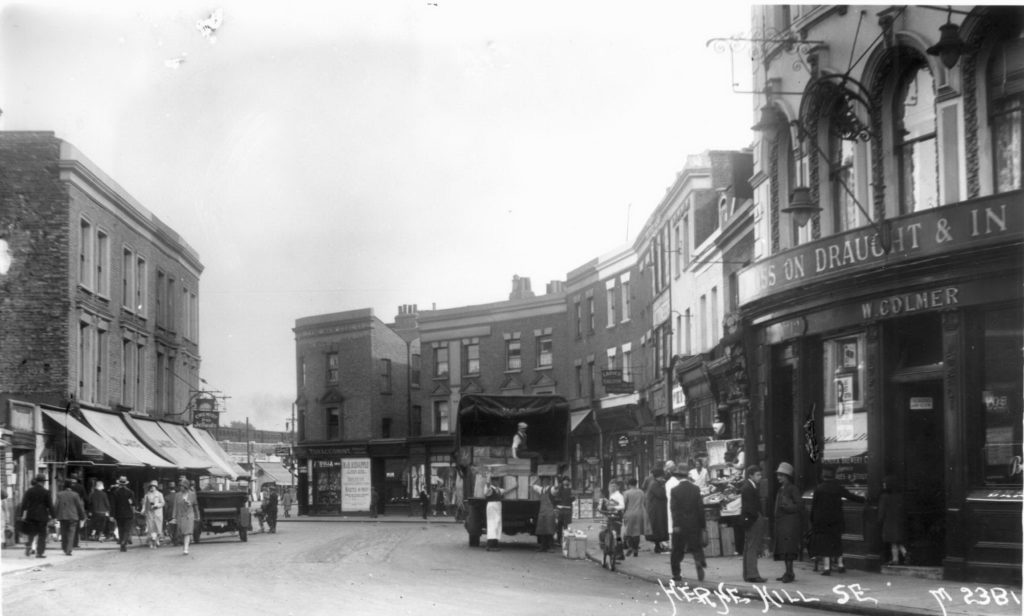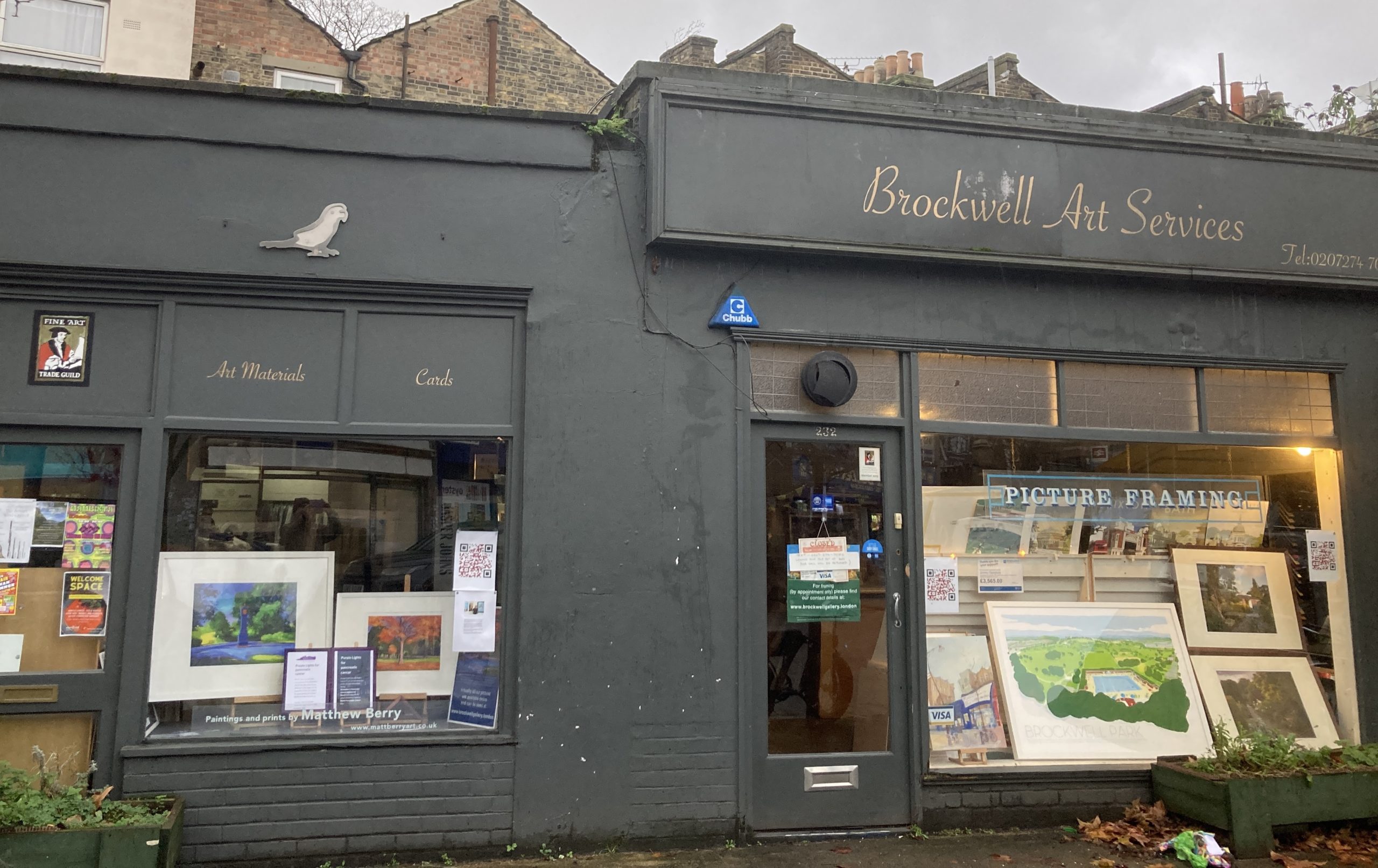Today, this is the home of Brockwell Art Services.
These were originally two shops and built with two storeys above for accommodation for the shopkeepers and their families. Damaged in World War II, the two houses never regained their upper storeys.
They were built in about 1885 and started life as Nos 7 and 9 Station Road before renumbering and renaming in 1888 as 232 and 234 Railton Road. In this image from the 1920s the upper storeys of 232-234 can be seen (behind the van being unloaded).

One J. Wheeler, a tailor, is recorded as the occupant of 232 in 1894. By 1897 George Fido is shown in directories as trading as a photographer and frame maker. George Fido was born in 1862 in Somerset, at or near Drayton (between Yeovil and Taunton), son of Sarah and William, an agricultural labourer, one of eight children. By 1891 he is apprenticed as a carpenter in Nailsea. Ten years later the 1901 census shows George, aged 39, resident at 232 Railton Road, a picture-frame maker working at home on his own account, married to Sarah, aged 36 (the age seems to be inaccurate), born in South Moreton, Berkshire (three miles from Didcot). They have one child, Daisy, aged eight, born in Claverham, Somerset.
The 1911 census shows George Fido as resident at 232 Railton Road, aged 50, occupation “stationer on own account”, with wife Sarah aged 52, and daughter Daisy, 18, assisting in the business. They have four rooms. The 1897, 1901 and 1903 directories refer to George also as a photographer, with no mention of this in the 1901 or 1911 censuses. The 1907 directory gives him as a “fancy dealer”. These variations suggest he tried his hand at a number of trades. However, there were a significant number of stationers trading in Herne Hill at this time (including next door at 234). Competition must have been fierce!
“Frederick Smith” has taken the place of George Fido and is trading from 232 Railton Road as an umbrella maker. For reasons unknown, Frederick Smith was not his true name. Possibly he wanted people to associate him with James Smith & Sons, the famous London umbrella-makers (est.1830) whose shop survives to this day at New Oxford Street. The many Frederick Smiths living in Lambeth 100 and more years ago has made research more difficult. It has, however, been possible to find our “Frederick Smith”. He was Sidney A. Buxton, born in 1871 in Brixton. The 1881 census shows his father to have been Dick H. Buxton, at that time a “soap refiner master”. He came from Upchurch, Kent. The family lived in Studley Road, Stockwell. By 1891 Sidney was working as an apprentice in a carpet warehouse. His father was now agent for a cigar maker. By 1901 he was still living with his parents, though married to Louisa, with a daughter, Helen, aged six months. Sidney, 29, is now an umbrella maker working on his own account. Brother Clarence, 20, is also an umbrella maker.
By 1907 Sidney was trading (as Frederick Smith) a few doors down at 206 Railton Road as an umbrella maker, before moving to 232. He also uses the name “Frederick Smith” on the Electoral Register.
But in the 1911 census for 206 Railton Road he is Sidney Buxton. His wife Louisa is helping in the business and they have two children: Helen Silvestra Buxton, aged 10, and Dick Hadlow Buxton, aged nine, both born in Clapham. In the 1921 census the family are at 232 Railton Road and all named Smith, with Sidney as “Frederick”. Both children are helping their father in the business. Sidney and Louisa remained at 232 Railton Road until World War II, being shown as there in the 1939 Register. Louisa died in 1960 and Sidney in 1940.
It is remarkable that in 1921 (Hughes Business Directory) there were some 150 umbrella makers, firms and individuals, working in London.
The other half (234 Railton Road) of what is today Brockwell Art Services, proprietor James Davidson, was from c.1894 and for some 25 years a stationer’s shop, that of Edmund Hope.
Edmund Hope was born in 1851. He was baptised at the Cathedral and Parish Church of Manchester. His father, also named Edmund Hope, is recorded in the register of baptisms as an engraver. His mother’s name appears as Mary Horrocks. Both his parents came from what is now Greater Manchester.
The 1871 census shows Edmund, aged 19, living with his parents at 78 Gloster Street, a multi-occupied house in Westminster. His father is employed as an engraver in calico printing. Edmund is working as a clerk for brush manufacturers.
Edmund married in 1892, the marriage registered in Lambeth. By 1894 they had the shop at 234 Railton Road. His wife Ellen was 17 years younger and came from Northallerton, Yorkshire. They had five children. The 1911 census identifies them as Philip, Dorothy, Connie, Nellie and Leonard (aged 18, 16, 14, 12 and 10). All the children, except perhaps the eldest, would have been born in Herne Hill.
The 1901 and 1911 censuses show the family living above the shop at 234 Railton Road. In 1901 the household included one general servant, but in 1911 there is none, possibly because of the expense of the large family. In 1911 both Ellen and Connie are shown as assisting in the business.
Edmund died in 1918, aged 66. He seems to have run the shop until his death. It appears from directory entries that in the following year (1919) the shop ceased business at 234, but Ellen Hope was now working at 226 as a hairdresser. The same year, eldest son Philip Hope is running a newsagents at 228, and the following year he has gone but his mother has given up hairdressing and has taken over the newsagents.
The move to 228 is confirmed by the register of St Jude’s (Dulwich Road) that records the baptism in April 1919 of Nellie’s daughter Phyllis Pearl Buckingham (born 10 March 1919) and Nellie’s address as 228 Railton Road.
By the time of the 1921 census the Hope family had left Herne Hill and moved to 73 St Kilda Road, West Ealing. All children except Philip live with her, and all work for companies engaged in metal manufacturing. In addition there is Robert Love, carpenter-joiner, married to her daughter Dorothy. Nellie (Mrs Buckingham), aged 23 but already a widow, has a daughter, Phyllis aged two.
Nellie’s marriage is a bit of a mystery. The baptism record (see above) of her daughter Phyllis gives the parents’ names as Phil and Nellie Buckingham and the father’s occupation as “Lieutenant in RFC”. There is no mention of the father being deceased. There is no record of a marriage that fits the known facts. But there is a record of Philip Edward Buckingham, holder of the MC, a lieutenant in the recently established Royal Air Force being killed in action on 8 November 1918 in Flanders, just three days before the Armistice and six days before his 22nd birthday. This is the only person to die in the RFC/RAF with the name Philip Buckingham. A newspaper report in the Reading Mercury (30 November 1918) suggests that Philip Buckingham came from a different social background to Nellie, the daughter of a Herne Hill shopkeeper. He was educated at Newbury Grammar School and Churcher’s, an independent school in Petersfield, where he excelled at sports. He served with the 10th Battalion, Bedfordshire Regiment and the 1/2nd Battalion, Queen’s Own (Royal West Kent Regiment), winning the MC on 1 November 1917. He qualified as a pilot in the month before his death. He died without leaving a Will, his estate amounting to £202. Administration went to his father, and Philip’s address is that of his parents in Newbury.
One can conclude that Philip and Nellie never married, but for the sake of Nellie’s child it was better that she did not suffer the stigma of illegitimacy. It may be that Philip’s family were unaware of Philip’s child.
It seems that Nellie’s mother, Ellen Hope, returned to South London, because, now in her 70s, she is shown in the 1939 register living with her granddaughter Phyllis, at 37 Gateley Road, Brixton. Phyllis works as a hairdresser’s receptionist.
The 1939 register shows Ellen Hope’s eldest child, Philip Edmund Hope, living at 2 Thurlby Road, Streatham, and employed as a bus driver. He was married to Olga Mary Rebecca, née Krafft. Her father was Ernest Richard Oscar Krafft, born in Germany in 1860. Philip died in 1963. He and Olga are buried in West Norwood Cemetery.
This article forms part of the “History of Shops” project, created and researched by the Herne Hill Society.

